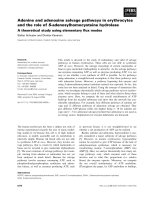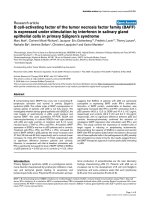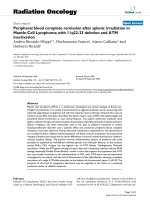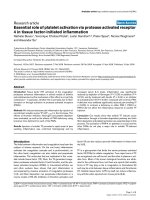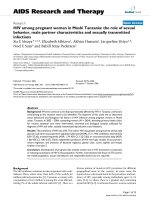Chemoresistance in b cell lymphoma role of apoptosome activation
Bạn đang xem bản rút gọn của tài liệu. Xem và tải ngay bản đầy đủ của tài liệu tại đây (1.43 MB, 148 trang )
CHEMORESISTANCE IN B CELL
LYMPHOMA: ROLE OF APOPTOSOME
ACTIVATION
Sun Yu
(MBBS, China/ Licentiate, Sweden)
A THESIS SUBMITTED
FOR THE DEGREE OF DOCTOR OF PHILOSOPHY
DEPARTMENT OF PHYSIOLOGY
NATIONAL UNIVERSITY OF SINGAPORE
2005
ACKNOWLEDGEMENTS
This study was initiated as collaboration between the Department of Physiology,
National University of Singapore, and the Institute of Environmental Medicine,
Karolinska Institutet. I would like to express my gratitude to the followings.
Shazib Pervaiz, my supervisor, Associate Professor in the Department of Physiology,
National University of Singapore, thanks for bringing me into this interesting scientific
area. Your knowledgeable guidance and smart idea from the beginning really built the
basis of this study. I appreciate the flexible environment you provided and constant
support.
Bengt Fadeel, my supervisor, Associate Professor in the Division of Molecular
Toxicology of Karolinska Institutet, thanks for your scientific guidance,
knowledgeable discussion, constant encouragement, and the fully support. I also thank
you for the opportunities you gave me to attend international conferences from where I
opened my eyes to the scientific world and really indulge in it.
Sten Orrenius, my supervisor, Professor in the Division of Toxicology of Karolinska
Institutet, thanks for the effort from you to initiate this collaboration. And also thanks
for every wonderful discussion with you on this study. Even you were very busy, but
you really put much energy into the study and make it going smoothly.
I am grateful for all the scientific discussions and technique supports from the
following people in Karolinska Institutet, Stockholm: Bertrand Joseph, Ping Huang,
Leta Nutt, Barbett Bartling, Mihails Baryshev, Souren Mkrtchian, Yvonne Hofmann
and Jue Wang. Thanks for your selfless sharing your experience and idea with me.
My dear colleagues from Apoptosis and Tumour Biology Lab in Physiology, I really
cherish the friendship among us. I am proud of to be the one of you and to be working
with you. Christopher, thanks for your patience to teach me the western blot and others.
Jayshree and Tini, thanks for the general guidance and instructions of the lab, which
provide me an easier and comfort working. Tze Wei, specially thanks to you for your
always help and scientific discussion even when I was far away in Sweden. And thanks
all the other members from the lab for your entertainment with me and friendly
environment you created.
I specially want to thank and give this thesis to my family, my husband, my parents
and my brother. During my PhD study, you are always with me and support me far
away from China. Thanks for all the love you give me.
This work was supported, in part, by grants from the National Medical Research
Council of Singapore, Swedish Children’s Cancer Foundation, the Swedish Research
Council, and the joint graduate student program of Karolinska Institutet and the
National University of Singapore.
i
TABLE OF CONTENTS
Acknowledgements i
Table of Contents ii
Summery vi
List of Tables vii
List of Figures viii
Abbreviations xi
List of Publications xiv
PART I INTRODUCTION 1
1. B CELL LYMPHOMA 1
1.1 Genetic background of Burkitt lymphoma 1
1.2 Sensitivity of BL to chemotherapy 3
2. APOPTOTIC SIGNALING PATHWAY 4
2.1 Genetic control of apoptosis 4
2.2 Apoptotic signaling pathways in mammals 5
3. THE APOPTOTIC MACHINERY 6
3.1 Extrinsic (death receptor-mediated) apoptosis signaling: DISC formation and
regulation 6
3.2 Intrinsic (mitochondria-dependent) apoptosis signaling: apoptosome formation and
activation 10
4. CHEMORESISTANCE: DEFECTIVE OF APOPTOSOME ACTIVATION IN
APOPTOTIC SIGNALING PATHWAY 16
4.1 Regulation of Apoptosis by anti-apoptotic members of Bcl-2 family 17
4.2 Defective expression of Apaf-1 with chemoresistance 20
4.3 Heat Shock Proteins as inhibitors of apoptosome formation 21
4.4 Other factors regulating apoptosome formation 22
4.5 Inhibition of apoptosome function by targeting caspases, the role of IAPs in
chemoresistance 23
ii
5. OTHER KEY PLAYERS IN CHEMORESISTANCE, FROM BL GENETIC
BACKGROUND 26
5.1 EBV related proteins 26
5.2 c-MYC and P53 27
PART II AIM OF THE STUDY 31
PART III MATERIAL AND METHODS 32
1. Cell lines 32
2. Apoptosis-inducing agents and induction of apoptosis 32
3. Generation of stable Apaf-1 over-expressing cell lines 34
4. Apoptosis assays 35
4.1 Morphological assessment of nuclear condensation and fragmentation by Hoechst
33342 35
4.2 Analysis of DNA fragmentation assessment by PI incorporation 35
4.3 MTT Reduction assay 36
4.4 Determination of caspase activities 36
4.5 Detection of membrane Phosphatidylserine (PS) exposure 37
4.6 Analysis of mitochondrial transmembrane potential 37
4.7 Detection of apoptotic related proteins by western blot analysis 40
5. In vitro cell-free systems 40
5.1 Generation of S-100 cytosols and cell-free apoptosis assays 41
5.2 Assessment of apoptosome formation 41
5.3 Immunoprecipitation 42
5.4 Cytochrome c and Smac release 42
6. Molecular approaches 43
6.1 Apaf-1 sequencing 43
6.2 AsHsp27 (antisense) pCDNA3.1 (+) construct 44
6.3 Transient transfection of AsHsp27 44
Appendix: Buffers used in the study 45
PART IV RESULTS 48
iii
1. Human BL-derived cell lines are resistant to apoptosis triggered by the
chemotherapeutic drug, etoposide: evidence for a post-mitochondrial defect 48
1.1. Raji B cells are resistant to etoposide-induced apoptosis 48
1.2. BL cell lines are resistant to etoposide-induced caspase activation both in vivo
system and in cell free system 51
1.3 Post-mitochondrial apoptotic defects in the Raji BL cell line 55
1.4 Subthreshold levels of Apaf-1 in the cytosol of human BL cells 60
1.5 Defective apoptosome activation in the human Raji BL cell line 60
1.6 Overexpression of Apaf-1 restores sensitivity to apoptosis in the Raji BL cell line
67
2. Plasma membrane sequestration of Apaf-1 contributes to BL cells resistance to
etoposide and staurosporine-induced apoptosis 71
2.1 Plasma membrane sequestration of Apaf-1 in chemoresistance BL cells 71
2.2 Reversal of chemoresistance in human BL cells upon liberation of Apaf-1 78
3. The role of IAPs and Smac in chemoresistant BL cells 78
3.1 IAPs are highly expressed in BL-derived cell lines, and serve to modulate apoptosis
in these cells in an apoptosome-dependent manner 80
3.2 Smac release is defective in BL-derived cell lines: introduction of cell-permeable
Smac N7 peptides potentiate Raji cells to apoptosis in an Apaf-1-dependent manner
85
4. Other apoptotic inhibitors in BL cell lines 88
5. Alternative apoptotic pathway in BL cells 92
PART V DISCUSSION 103
1. The role of the apoptosome in controlling the sensitivity of cancer cells to
chemotherapeutic agents 103
2. Intracellular requirements for post-mitochondrial molecules, such as the IAPs, to
control apoptosis in BL-derived cell lines 107
3. Cytochrome c and Smac release in BL cells 111
4. Alternative apoptosis window opened in chemoresistant cells 113
5. The role of other inhibitors of apoptosis in the modulation of apoptosis in BL cells
114
iv
6. Proteasome in apoptosis and cancer therapy 115
PART VI CONCLUSIONS 117
PART VII REFERENCES 119
v
Summary
Chemoresistance is a major clinical problem in the treatment of cancer, and is thought
to be related to an underlying resistance to apoptosis (programmed cell death) in cancer
cells. In the present study, Burkitt’s lymphoma (BL)-derived B cell lines were used to
investigate the intracellular signaling pathways involved in apoptosis induction by
chemotherapeutic agents; in particular, we focused on post-mitochondrial signaling
and its implications for chemoresistance.
Apaf-1 (apoptotic protease-activating factor-1) is the main component of a protein
complex termed the apoptosome, which is required for caspase activation downstream
of mitochondria. Upon release from these organelles, cytochrome c binds to Apaf-1
thus driving its oligomerization; this results in the activation of caspase-9 and caspase-
3, and the rapid dismantling of the cell. In the B cell lines utilized herein, cytochrome c
failed to stimulate apoptosome formation and caspase activation, and this was shown to
be due to insufficient levels of Apaf-1 in the cytosolic compartment. However, the
level of Apaf-1 in total cellular extracts was normal. Enforced expression of Apaf-1
increased its concentration in the cytosol, restored cytochrome c-dependent caspase
activation, and rendered the prototypic BL cell line Raji sensitive to etoposide- and
staurosporine-induced apoptosis. Subsequent investigations revealed that, in Raji BL
cells, the bulk of Apaf-1 was sequestered in the plasma membrane. Moreover,
liberation of Apaf-1 using lipid raft-disrupting agents served to sensitize BL cells to
chemotherapeutic drugs. Our studies also show that IAPs (inhibitor of apoptosis
proteins) are highly expressed in BL cell lines. The combination of Smac peptides,
which serve to antagonize IAPs, thereby alleviating caspase inhibition, and
staurosporine triggered apoptosis in Apaf-1-overexpressing BL cells, but failed to do
so in mock transfectants. Similar results were obtained when Smac peptides were
added together with the proteasome inhibitor, lactacytsin. Hence, Smac-mediated
potentiation of apoptosis was shown to be Apaf-1-dependent, and IAPs were
concluded to modulate the sensitivity to apoptosis in this model.
In sum, these studies are the first to show that plasma membrane sequestration of Apaf-
1, a key component of the apoptosome, may render cancer cells resistant to treatment.
From the point of view of clinical utilization of apoptosis-targeted therapies, our results
suggest that IAP modulation using, for instance, Smac peptides or Smac mimetics, may
be beneficial only if sufficient amounts of Apaf-1 are present. Our results also suggest
that proteasome inhibition-triggered apoptosis is dependent on apoptosome formation.
The latter findings may be of potential importance since clinical trials using
proteasome inhibitors are currently ongoing in several hematological malignancies.
vi
LIST OF TABLES
Table 1. EBV status in BL derived cell lines used in the study 28
Table 2. P53 status in BL derived cell lines used in the study 30
vii
LIST OF FIGURES
INTRODUCTION
Figure 1. Apoptotic signaling pathway, the key role of apoptotic complex formation 7
Figure 2. Apaf-1 isoforms and schematic model for apoptosome formation 12
Figure 3. Overall structure of the WD40-deleted Apaf-1 bound to ADP 15
Figure 4. IAPs family members and schematic model for functional domains 25
MATERIALS AND METHODS
Figure 5. Methodology flow chart 33
Figure 6. Apoptosis analysis by Hoechst 33342 staining and PI incorporation 38
Figure 7. Time-dependent AMC release curves 39
RESULTS
Figure 8. Raji cells were resistant to etoposide treatment 49
Figure 9. Raji cells failed to expose phophatidyl serine upon etoposide treatment 50
Figure 10. Raji cells were defective in caspases activation as indicated 52
Figure 11. Quantification of CD95 and Bcl-2 expression in Raji and Jurkat cells 53
Figure 12. BL cells were resistant to etoposide 54
Figure 13. Defective caspases activation in BL cells 56
Figure 14. Etoposide induced mitochondria changes in Raji cells 58
Figure 15. Cytochrome c release upon triggering apoptosis in Raji cells 59
Figure 16. Exogenous cytochrome c failed to induce caspase-3 activation in S100 cytosols
from BL cells 61
Figure 17. Wide type caspase-3 could be cleaved independent of apoptosome in BL cell
lines 62
Figure 18. Subthreshold level of cytosolic Apaf-1 in BL cell lines 63
Figure 19. Apoptosome formation in Jurkat cells 65
Figure 20. Defective apoptosome formation in Raji cells 66
Figure 21. Stable overexpression of Apaf-1 in Raji B cells 68
viii
Figure 22. Overexpression Apaf-1 sensitized Raji cells to etoposide and staurosporine 69
Figure 23. Overexpression Apaf-1 sensitize S100 cytosol of Raji cells to dATP and
cytochrome c apoptosis 70
Figure 24. Apaf-1 cytosolic distribution in Raji cells by immunofluorescent staining 72
Figure 25. Plasma membrane sequestration of Apaf-1 in BL cells 73
Figure 26. Methyl-beta-cyclodextran (MCD) or cytochalasin B (CB) mobilize Apaf-1 from
plasma membrane to cytosol in Raji cells 75
Figure 27. Defective Apaf-1 redistribution by MCD in Jurkat cells 76
Figure 28. Mobilization of plasma membrane associated Apaf-1 sensitized Raji cells S100
cytosol to apoptosis 77
Figure 29. MCD sensitized BL cells to etoposide induced apoptosis 79
Figure 30. IAPs especially cIAP2 highly expressed in Raji BL cells 81
Figure 31. Immunodepletion of cIAP2 could not sensitize Raji S100 cytosol to cytochrome
c and dATP induced caspase activation 82
Figure 32. Immunodepletion of cIAP2 sensitized S100 cytosol to dATP and cytochrome c
in RajiApaf-1 cells 83
Figure 33. Immunodepletion of cIAP2 sensitized Raji S100 cytosol to dATP and
cytochrome c in RajiApaf-1 cells 84
Figure 34. Defective Smac release in Raji cells upon staurosporine treatment 86
Figure 35. Exogenous Smac N7 peptide sensitized cell death was Apaf-1 dependent 87
Figure 36. Bcl-2 and Hsp27 expression in BL cells 90
Figure 37. IAPs were highly expressed in BL cell lines 91
Figure 38. Transient transfection of antisense Hsp27 silenced Hsp27 expression to 50% in
DG75 cells 94
Figure 39. BL derived cell lines showed different sensitivities to staurosporine and
lactacystin induced cell death 95
Figure 40. Cytochrome c and Smac release were cell type dependent in BL derived cell
lines upon 1uM staurosporine treatment 96
Figure 41. Cytochrome c release was not caspases dependent, however Smac release was
caspases dependent in MutuI and Ramos cells 97
Figure 42. Lactacystin and staurosporine induced caspases independent cell death in
Ramos 98
ix
Figure 43. Lactacystin and staurosporine induced caspases dependent apoptosis in Mutu I
cells 99
Figure 44. Smac release were cell type dependent in BL cell lines upon 1uM staurosporine
treatment 101
Figure 45. Defective dissipation of mitochondria trans-membrane potential in Ramos cells
upon treatment with lactacystin and staurosporine 102
DISCUSSION
Figure 46. Schematic model of mechanism of chemoresistance in Raji cells 104
x
ABBREVIATIONS
∆ψm mitochondria transmemrane potential
IF apoptosis inducing factor
AIP apoptosis-inducing protein
AMC 7-amido-4-methylcoumarin
Apaf-1 apoptotic protease-activating factor-1
APS ammoniumperoxodisulphate
dATP/ATP 2’-deoxyadenosine 5’-triphosphate/ 2-adenosine 5’-
triphophate
5-Aza 5aza 2'deoxycytidine
Bak BCL2-antagonist/killer
Bax Bcl-2-associated X protein
Bcl-2 B-cell lymphoma protein 2
BH Bcl-2 homology
Bid BH3 interacting domain death agonist
tBid truncated Bid
BIR baculoviral-IAP-repeat
BL Burkitt’s lymphoma
BPB bromphenol blue
CARD caspase recruitment domain
caspase cysteine-dependent aspartate-specific protease
CB cytochalasin B
ced Caenorhabditis elegans genes defective
CHAPS 3-[(3-Cholamidopropyl)dimethylammonio]-1-
propanesulfonate
CTB cholera toxin B
Cyt c cytochrome c
Dark Drosophila Apaf-1-related killer
DED death effector domain
DEVD-AMC N-Acetyl-Asp-Glu-Val-Asp-7-amido-4-methylcoumarin
DIABLO direct IAP-binding protein with low pI
DISC death-inducing signalling complex
DMRIE-C 1,2-dimyristyloxypropyl-3-dimethyl
hydroxyethylammonium bromide, monocationic
DMSO dimethyl sulfoxide
DNA deoxyribonucleic acid
DRs death receptor
DREDD death related ced-3/Nedd2-like protein
DTT dithiothreitol
E2 ubiquitin-conjugating enzyme
E3 ubiquitin-protein ligase
EBV Epstein-Barr virus
EBNA Epstein-Barr virus nuclear antigen
xi
EDTA ethylenediaminetetraacetic acid
EGL-1 EGg Laying defective
EGTA ethyleneglycotetraacetic acid
ELISA enzyme-linked immunosorbent assay
ER endoplasmic reticulum
Eto etoposide
FACS fluorescence-activated cell sorter
FADD Fas-associated death domain-containing protein
FBS fetal bovine serum
FITC fluorescein isothiocyanate
FLICE FADD-like ICE
FLIP FLICE-like inhibitory protein
fmk fluoromethylketone
GAPDH glyceraldehyde-3-phosphate dehydrogenase
HEPES 4-(2-hydroxyethyl)piperazine-1-ethanesulfonic acid
HSP heat shock protein
HtrA2 High temperature requirement protein A2
IAP inhibitor of apoptosis protein
ICE interleukin-1 β-converting enzyme
ID immunodepletion
IETD-AMC N-Acetyl-Ile-Glu-Thr-Asp-7-Amido-4-methylcoumarin
IP immunoprecipitation
Lac lactacystin
LEHD-AMC N-Acetyl-Leu-Glu-His-Asp-7-Amido-4-methylcoumarin
LMP1 latent membrane protein 1
Myc v-myc myelocytomatosis viral oncogene homolog (avian)
MCD methyl-β-cyclodextrin
Mcl1 myeloid cell leukemia sequence 1
beta-Me beta -mercaptoethanol
MES 2-morpholinoethanesulfonic acid
MM multiple myeloma
MOMP mitochondria outermembrane permeablilization
MTT Formazan 1-(4,5-Dimethylthiazol-2-yl)-3,5-diphenylformazan
NB-ARC nucleotide-binding domain shared by Apaf-1 certain R
gene products and CED-4
NBD nuleotide binding domain
NF-қB nuclear factor of kappa light polypeptide gene enhancer in
B-cells
NHL non-Hodgkin lymphoma
NP40 nonidet P40
PARP poly(ADP-ribose) polymerase
PBS phosphate buffered saline
PCD programmed cell death
PEG polyethylene glycol
xii
PI propidium iodide
Pro-T prothymosin-α
PS phosphatidyleserine
PUMA p53-upregulated modulator of apoptosis
BARF0 BamHI A rightward frame 0
RNA ribonucleic acid
RNase ribonuclease
RPMI1640 Roswell Park Memorial Institute 1640
RT-PCR reverse transcriptase-polymerase chain reaction
SDS sodium dodecyl sulfate
SDS-PAGE SDS-polyacrylamide gel electrophoresis
Smac second mitochondrial activator of caspases
STS staurosporine
TEMED N,N,N',N'-tetramethylethylenediamine
TMRE tetramethylrhodamine ethyl ester perchlorate
TNF-R tumor necrosis factor receptor
TRADD TNFR1 associated death domain protein
TRAIL TNF-related apoptosis inducing ligand
Triton X-100 polyoxyethylene(10) isooctylcyclohexyl ether
U unit
XAF1 XIAP-associated factor 1
zVAD benzyoxycarbonyl valanyl alanyl aspartyl
Mammalian IAP family members
XIAP/hILP/BIRC4 X-linked inhibitor of apoptosis protein/ human IAP-like
protein/ baculoviral IAP repeating-containing 4
BIRC1/NAIP baculoviral IAP repeating-containing 1/ neuronal
apoptosis inhibitory protein
cIAP1/MIHB/hIAP2/
BIRC2
cellular IAP1/ mammalian IAP homologue B/ human
homologue IAP2/ baculoviral IAP repeating-containing 2
cIAP2/MIHC/hIAP1/
BIRC3
cellular IAP1/ mammalian IAP homologue C/ human
homologue IAP1/baculoviral IAP repeating-containing 3
EPR-1/BIRC5 effector cell protease receptor-1/ baculoviral IAP
repeating-containing 5
BRUCE/BIRC6 BIR repeat-containing ubiquitin-conjugating enzyme/
baculoviral IAP repeating-containing 6 (also known as
Apollon)
ML-IAP/BIRC7 Melanoma IAP/ baculoviral IAP repeating-containing 7
ILP-2/BIRC8 IAP like protein 2/ baculoviral IAP repeating-containing 8
xiii
LIST OF PUBLICATIONS
1. Sun Y, Orrenius S, Pervaiz S, Fadeel B. Plasma membrane sequestration of
apoptotic protease-activating factor-1 in human B-lymphoma cells: a novel
mechanism of chemoresistance. Blood. 2005 May 15;105(10):4070-7. Epub
2005 Feb 3.
2. Sun Y, Pervaiz S, Fadeel B. Smac-mediated potentiation of apoptosis of B
lymphoma cells requires cytosolic Apaf-1 expression. (manuscript under
submission)
CONFERENCE PAPERS
1. Sun Y. Mechanism of chemoresistance in B lymphoma: defective Apaf-1-
dependent activation of executioner caspases (updated results). Apoptosis in
Biochemistry and Structural Biology (J6). Keystone, Colorado, USA, February
3-8, 2004.
2. Sun Y, Pervaiz S and Fadeel B. Mechanism of chemoresistance in B
lymphoma: defective Apaf-1-dependent activation of executioner caspases. 11
th
Euroconference on Apoptosis- Cell Death under the Tower. Ghent, Belgium,
October 25-28, 2003.
xiv
1
INTRODUCTION
1. B CELL LYMPHOMA
Cancer is, essentially, a genetic disease (Vogelstein and Kinzler, 2004), and resistance
to apoptosis is one of several cardinal features of most cancer cells (Hanahan and
Weinberg, 2000). B cell lymphomas (the focus of the present thesis) are a diverse
group of malignant disorders that vary with respect to their molecular features,
genetics, clinical presentation, treatment approaches, and outcome. Over the past few
years, through an increased understanding of the biology of these diseases, new
therapies, including a combination of cancer-targeted antibodies and chemotherapy,
or new chemotherapeutic regimens, have been developed. The challenge of clinical
research is to optimize the use of these agents, select those patients most likely to
respond, and develop multi-targeted strategies based on a sound scientific rational,
with the potential to increase the cure rate of patients with lymphomas (Cheson, 2004).
1.1 Genetic background of Burkitt lymphoma
1.1.1 c-MYC
Burkitt’s lymphoma (BL) is a highly aggressive non-Hodgkin lymphoma (NHL)
consisting of endemic, sporadic, and immunodeficiency-associated variants. Eighty
percent of BL cases harbor t(8;14), resulting in the juxtaposition of the c-myc gene on
chromosome 8 with IgH enhancer elements on chromosome 14 which drive c-Myc
mRNA and protein production. In the remaining 20% of BL cases, translocations
occurring between chromosomes 2 and 8, t(2;8)(p12;q24), or chromosomes 8 and 22,
t(8;22)(q24;q11), place the c-myc gene adjacent to either κ or λ light chain loci and
2
enhancer elements , respectively. As heavy chain and light chain loci are specifically
active in mature B cells, it is not difficult to understand how c-myc transcription is
favored in BL harboring t(8;14), t(2;8), or t(8;22) (Blum et al., 2004). C-Myc over
expression is one of the most featured genetic backgrounds which directly or
indirectly target expression of many genes involved in cell cycle regulation, apoptosis,
cell growth, cell adhesion, and differentiation (Blum et al., 2004). It is also hard to
attribute any one single alteration to lymphogenesis and chemotherapy responses.
1.1.2 EBV status
Epstein-Barr virus (EBV), a γ-herpesvirus, was discovered 40 years ago from
examining electron micrographs of B cells cultured from BL specimens. Far from
showing a restricted distribution, EBV was found to be widespread in all human
populations and to persist in the vast majority of individuals as a lifelong,
asymptomatic infection of the B-lymphocyte pool. Despite this, the link between EBV
and endemic BL proved consistent and became the first of an unexpectedly wide
range of associations discovered between this virus and tumours (Liston et al., 1997).
EBV establishes a life-long latent infection within B lymphocytes. Latency is
associated with the expression of as many as ten viral proteins, including a family of
six nuclear proteins (EBNAs), three integral latent membrane proteins (LMPs) and the
recently identified polypeptide RK-BARF0 (Kelliher et al., 1998). Several of these,
most notably the EBNA-3 protein, elicit a strong EBV-specific cytotoxic T-
lymphocyte immune response. Through differential expression of EBV proteins that
are immunogenic, potentially oncogenic, and those necessary for sustaining infection,
equilibrium is established between infected B cells and the host’s immune
surveillance. As a consequence, a relatively stable pool of latently infected cells is
3
maintained by the host. Thus, EBV is particularly well adapted for persisting within B
lymphocytes of an immune host. As a result of the balanced relationship that exists
between EBV and its host, pathogenesis associated with EBV latency is generally a
consequence of either an immune deficiency, leading to EBV-induced immunoblastic
lymphoma, or a known or suspected secondary genetic or environmental event that
promotes full oncogenic transformation of latently infected cells (Kieff, E. 1996). In
contrast to tumors such as Hodgkin’s lymphoma and nasopharyngeal carcinoma,
LMP-1 is not expressed in EBV positive BL, in which the pattern of viral gene
expression, referred to as type I latency, is restricted to the proteins EBNA-1 which is
required for EBV DNA maintenance. Even so, unlike c-MYC, there is no direct
evidence that EBNA-1 contributes to tumorigenicity in EBV-associated malignancies
(Wilson et al., 1996). Interesting results of in vitro experiments correlate EBV
associated tumorigenesis of EBV-negative BL cells with an increased resistance to
apoptosis that is coincident with down-regulation of c-MYC protein and increased
expression of anti-apoptotic protein Bcl-2 (Ruf et al., 1999). Therefore, the relation of
EBV with tumorigenesis, especially the role of apoptosis modulating the EBV related
tumorigenesis has been the focus of a number of recent studies.
1.2 Sensitivity of BL to chemotherapy
In general, BL patients are sensitive to high-intensive chemotherapy; however, current
treatments are suboptimal for some categories of patients (eg. patients with relapsed
disease), and therefore other strategies are emerging to overcome the resistance in
poor prognosis and relapsed disease, based upon a better understanding of the
molecular basis of these tumors.
4
It is well established that chemotherapeutic drugs kill cancer cells by inducing
apoptosis; conversely, dysregulation of the apoptosis program in a cancer cell may
account for the failure of clinical treatment of cancer, including B lymphomas (Arnt et
al., 2002). Hence, resistance to apoptosis may play a crucial role not only in
carcinogenesis, but also in resistance to treatment with conventional therapies. In the
current study, the mechanism of BL chemoresistance was investigated by directly
targeting and dissecting apoptotic signalling pathways. A panel of human BL-derived
B cell lines were used as an in vitro model system to decipher the molecular defects in
apoptotic signalling as a mean to understand chemoresistance.
2. APOPTOTIC SIGNALING PATHWAY
Most, if not all, chemotherapeutic drugs trigger apoptosis, a form of programmed cell
death (PCD), first described and characterized in the early 1970s by Wyllie and Kerr
(Kerr et al., 1972). Apoptosis is a genetically controlled form of death which is
important during embryonic development, negative selection of self reactive
lymphocytes, and plays a crucial role in homeostasis of adult organisms (Jacobson et
al., 1997). The phenomenon is based upon discreet morphological and biochemical
changes observed during commitment and execution of the death signal (see later),
followed by engulfment by neighboring cells, thus preventing a harmful inflammatory
response (Fadeel et al., 2004). Being genetically regulated makes apoptosis amenable
to therapeutic intervention.
2.1 Genetic control of apoptosis
5
The initial insight into the genetic basis of apoptosis, was gained from ingenious
studies on the nematode, Caenorhabditis elegans (Horvitz, 1999). These studies
revealed a conserved pathway, whereby the products of two genes, designated ced-3
and ced-4 (ced, cell death abnormal), were shown to be necessary and sufficient to
trigger the perfectly timed and orchestrated death of 131 cells during the development
of the worm. The relevance of this pathway to higher animals was established by the
discovery of mammalian orthologs of these genes and the demonstration that the
mammalian ced-3-related genes encode proteases (designated caspases) were
responsible for the morphological changes associated with that of apoptosis
(Hengartner, 2000).
2.2 Apoptotic signaling pathways in mammals
Due to the conserved molecular basis and biochemical processing in different species
- from C. elegans, Drosophila melanogaster, to mammalian cells, a wide body of
work has unraveled the intricate networks involved in apoptotic signaling and
provided novel targets for better management of tumors that harbor defects or
deficiencies in the signaling circuitry. Two main apoptotic pathways have been
characterized in recent years, an intrinsic (mitochondria-dependent) pathway and an
extrinsic (mitochondria-independent) pathway (Danial and Korsmeyer, 2004). Even
though the initiator caspases for the two main apoptotic pathways are recruited and
activated on the DISC and Apoptosome respectively and independently, the cross-talk
between the two initiator caspases is bridged by other intracellular molecules, like
BH3 only Bcl-2 family member Bid. Activated caspase-8 not only initiates
mitochondria independent apoptotic pathway, also by targeting and cleaving Bid to
truncated Bid (tBid) to activate the mitochondria dependent apoptotic pathway. tBid
6
inserts into the mitochondria outer-membrane, perturbs mitochondrial transmembrane
potential and therefore motivates the mitochondrial release of cytochrome c. The
released cytochrome c helps to oligomerize Apaf-1 to form the seven-spoked big
protein complex, the apoptosome. The main apoptotic pathways are hence connected
by tBid.
In both cases, intracellular proteases belonging to the caspase family are processed
through direct (linear) or feedback amplification steps. In the case of the latter,
upstream initiator caspases are activated in one of two large protein complexes,
namely the DISC (Death inducing signaling complex) and the apoptosome; (other
platforms for caspase activation, such as the inflammasome and the PIDDosome, may
also exist) (Martinon et al., 2002) (Tinel and Tschopp, 2004), and the executioner
caspases being processed downstream of the initiator caspases in a cascade manner
(Figure 1).
3. THE APOPTOTIC MACHINERY
3.1 Extrinsic (death receptor-mediated) apoptosis signaling: DISC formation and
regulation
3.1.1 Death receptors oligomerization initiates DISC formation
Certain members of the tumour necrosis factor receptor (TNF-R) superfamily are
involved in transducing apoptosis signals, and these proteins are therefore referred as
the “death receptors” (DRs), a subset of type I transmembrane receptors TNF-R.
Members of this family contain one to five cysteine-rich repeats in their extracellular
domain, and a so-called death domain (DD) in their cytoplasmic tail. Studies
regarding these receptors in a variety of cell types and tissues have revealed that the
7
Fas ligand
Fas
FADD
caspase-8
and/or
caspase-10
caspase-3
Bid tBid
cytochrome c
caspase-9
Proteolysis of death substrates
Apaf-1
DISC
Apoptosome
mitochondrion
Bcl-2
plasma membrane
Figure 1. Apoptotic signaling pathway, the key role of apoptotic complex
formation. Apoptotic complex in both extrinsic and intrinsic apoptotic signaling
pathways serve to initiate and amplify executioner casapases in these two
pathways. DISC formation provides executioner caspase-8 or caspase-10 platform
to activation followed with extrinsic signals transduced into cells by death
receptors. Intrinsic signals target to mitochondria and release proapoptotic factor-
cytochrome c to promote apoptosome formation which reaults in caspase-9
activation.
8
DD is essential for transduction of the apoptotic signal by bringing about the physical
assembly of a complex of molecules into a signaling complex, termed the DISC.
CD95 (also known as Apo-1 or Fas) is one such family member and plays a
significant role in the development of a functional immune system and in
organogenesis (Krammer, 2000). The interaction between CD95 and its ligand
(CD95L) induces receptor oligomerization, most probably a trimerization, of CD95 is
required for transduction of the apoptotic signal and DISC assembly. The DISC forms
within seconds of receptors engagement brought about by the adaptor FADD (Fas-
associated death domain protein) which binds via its own DD to the DD of CD95.
FADD also carries a so-called death-effector domain (DED), and, again by
homologous interaction, recruits the DED-containing pro-caspase-8 (also known as
FLICE) into the DISC.
Several different types of DISCs have been reported in cells undergoing apoptosis.
The main difference in their molecular structure is the involvement of different
bridging molecules, such as FADD or TRADD, which are initially controlled by
oligomerization of different DRs. For instance, oligomerized CD95 (Fas) or TRAIL-R
bridges FADD, and TNF-R1 oligomerization recruits TRADD as an adaptor to further
recruit another DISC complex II to the complex I
(Micheau, and Tschopp, 2003).
Even though the composition of the DISC varies depending on the DRs, the protein-
protein interactions (DD: DD and DED: DED) follow a common final pathway for
execution of the extrinsic death signal.
3.1.2 Capasee-8/ 10 activation
Homotypic DED: DED interactions promote the binding of caspase-8 to FADD. In
this manner, the DISC acts as a molecular scaffold in which caspase-8 is activated
9
(Medema et al., 1997). It is believed that the FADD-enforced high local concentration
or “induced proximity” (Salvesen and Dixit, 1999), of caspase-8 monomers leads to
dimerization of this caspase, triggering pro-caspase-8 autocatalytic processing to
active caspase-8. Once cleaved, the active caspase-8 detaches into cytoplasm where it
can proteolytically chew up a variety of cellular proteins, including pro-caspase-3 (the
executioner), resulting in caspase-3 activation and dismantling of the cell. Hence,
DISC formation in extrinsic signalling pathway is crucial to recruit apoptotic
executioner, caspases. Although lacking in mice, humans also possess a second DED-
containing caspase, called caspase-10 (Hu et al., 1997; Ng et al., 1999). This caspase
has a high degree of homology to caspase-8, likely the result of a gene duplication
event via its proximity to the caspase-8 locus on human chromosome 2q33-q34.
Caspase-10 has also been shown to potently induce apoptosis in a manner similar to
caspase-8 (Kischkel et al., 2001; Sprick et al., 2002; Wang et al., 2001), and naturally
occurring mutations in this caspase have been shown to lead to autoimmune
lymphoproliferative syndrome (ALPS) (Wang et al., 1999). However, recent evidence
suggests that its substrate specificity may be distinct from caspase-8.
cFLIP is an additional molecule that is recruited to the DISC in many cases. It is
likely the result of a gene duplication event like caspase-10 in humans, although it is
also present in mice. cFLIP has a high degree of sequence homology with caspase-8.
A short form encodes a truncated protein containing only amino terminal tandem
DEDs and a short region of unique sequence, whereas a long isoform encodes a
molecule very similar to caspase-8 but lacking an active site cysteine necessary for
proteolytic activity (Thome and Tschopp, 2001).
10
3.2 Intrinsic (mitochondria-dependent) apoptosis signaling: apoptosome
formation and activation
For most chemotherapeutic drugs, the preferred pathway is the mitochondria-
dependent intrinsic signaling pathway. The identification of mitochondrial proteins as
the critical amplification factors involved in boosting the death signal provided the
basis for the intrinsic apoptotic pathway. Mitochondria are activated either directly or
indirectly by chemotherapeutic drugs or other forms of cellular stress (Green and
Kroemer, 2004). In the latter case, active forms of BH3-only Bcl-2 family members,
such as truncated Bid, translocate from the cytoplasm to the mitochondrial outer
membrane and trigger a dissipation of mitochondrial transmembrane potential and
release of cytochrome c from mitochondria. The release of pro-apoptotic molecules
from mitochondria serves to initiate the formation of the apoptosome.
3.2.1 Cytochrome c and its role in induction of apoptosome formation
The role of mitochondria in apoptosome formation was first studied by the discovery
that the mitochondrial inner membrane protein cytochrome c is released by apoptotic
stimuli (Zou et al., 1997). Cytochrome c is a small (in mammals, 104 amino acid
residues) and stable hemoprotein containing covalently bound heme c as a prosthetic
group.
In 1996 Wang and co-workers (Liu et al., 1996) discovered that cytochrome c was
involved in apoptosis. As a model of apoptosis, treatment of cell-free S100 cytosolic
extract from HeLa cells with dATP was used. It was found that the addition of dATP
to the extract resulted in typical apoptotic changes, i.e. (i) cleavage of the caspase-3
precursor yielding active caspase-3, (ii) nuclear DNA fragmentation and (iii) specific
morphological changes in the cell nucleus. Fractionation of the extract revealed the

